1lumen selects and reviews products personally. We may earn affiliate commissions through our links, which help support our testing.
Astrolux EA01 review
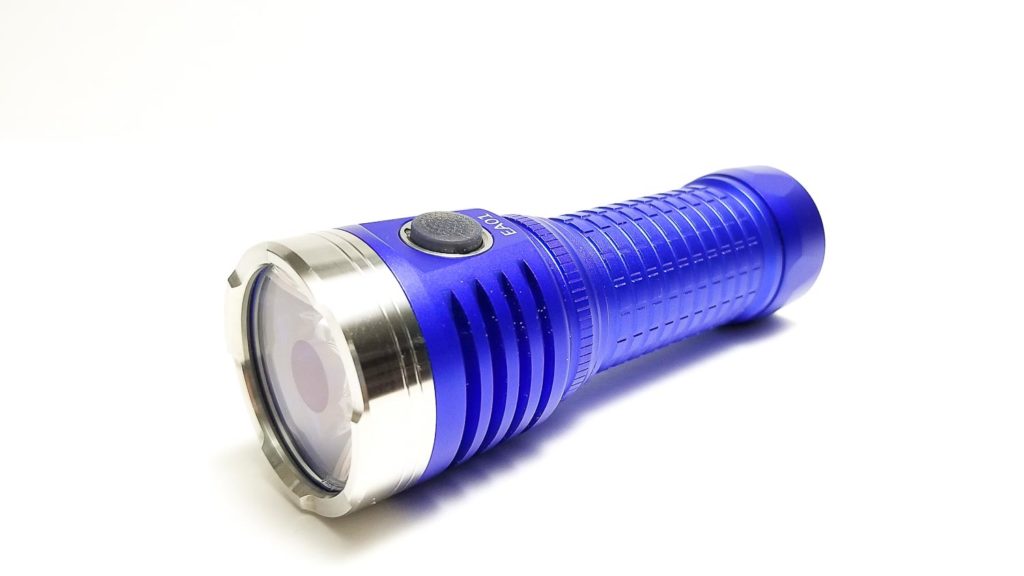
Astrolux EA01 specifications
| Brand/model | Astrolux EA01 |
|---|---|
| LED | CREE XHP50.2 |
| Lumens | 3,500 lm |
| Beam intensity | 68,000 cd |
| Battery config. | 1*26650/26350 |
| Material | Aluminum |
| Modes | Many (Anduril) |
| Blinkies | Many (Anduril) |
| Reflector | TIR optic |
| Waterproof | IPX7 |
| Review date | April 2021 |
Introduction:
Over the last couple years, I’ve noticed a trend in the flashlight industry, namely, a shift towards using optics instead of reflectors. Optics come in two popular styles, the Carclo-type optics found in the Lumintop FW3 series or Noctigon KR4, or larger versions like those found in the Acebeam L17 or Manker MC13. Optics make it possible to alter beam characteristics simply by changing the optic. More flood? Swap in a floody optic. Want more throw? Install a narrow-angle optic. For a while, optics were not all that common, however most all of the major brands have one or more models sporting optics. Astrolux, Banggood’s house brand, also got in on the action with their new EA01. This is a single emitter light which (no surprise) features an optic instead of a reflector. Is this an upgraded EC01 or an all new light? I’m excited to see how it performs.
Package quality.
Astrolux lights seem to have one thing in common: Utilitarian packaging, so no surprise when I opened the plastic mailing bag and voila, a plain recycled paper box with just the brand name and a sticker on the side with the product options. The light inside wasn’t knackered from its journey across the world, which means the box did its job. In the box, the EA01 was sitting in foam cut to shape with the included 26350 size battery tube. Other included items include a surprisingly comprehensive (and easy to read) user manual. The rest of the accessories were in a small baggie hiding inside the 26350 tube.
What You’ll Get:
- The Astrolux EA01
- 2 spare o-rings
- Lanyard
- Manual
- Battery adapter tubes
- 26350 short battery tube
This is a pretty complete kit, only missing a battery and USB type C cable (if you don’t have a charger) to get up and running. The accessories seem okay and maybe a little nicer than the price would suggest. Thanks Banggood.
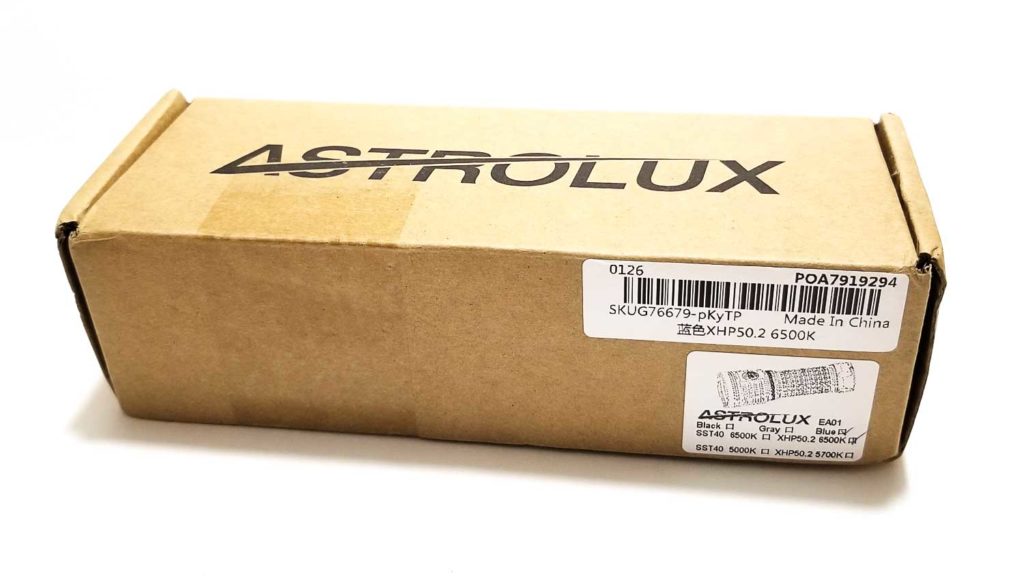
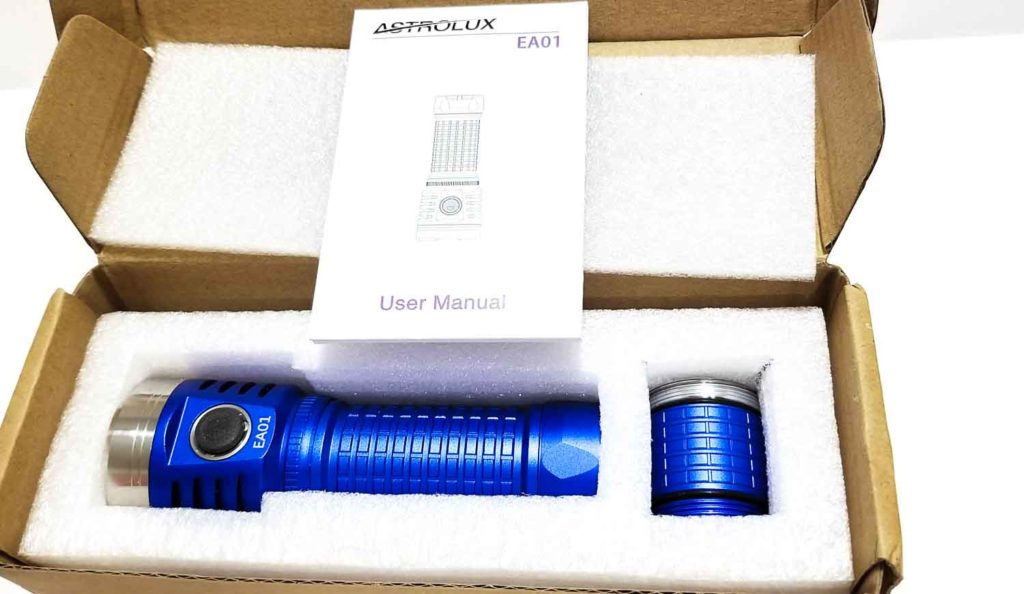
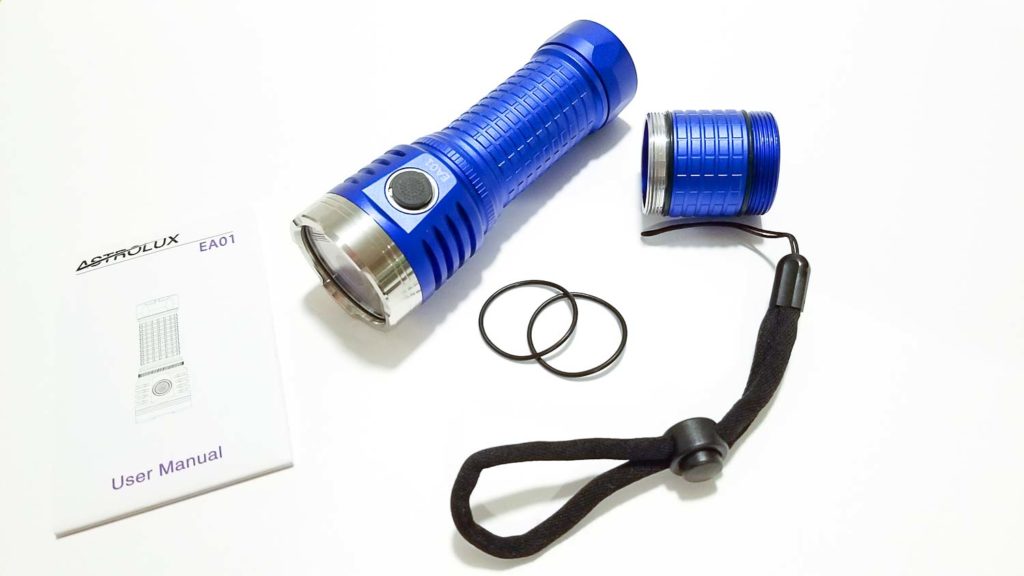
Flashlight in use
The light feels really nice in the hand. The 26650 size battery tube fills my big hands well, and the knobbly texturing on the battery tube makes it nice to hold. It’s a bit chunky for EDC, but you could if you wanted to, However, there’s no pocket clip, so you’re limited to lose pocket carry. I had no trouble reaching the front-mounted electronic side switch either. However, switching to the 26350 tube makes the light short and stubby, which made it awkward to handle. Although it’s a bit lighter and more pocketable, I think it just looks silly with that short tube.
The silicone switch button protrudes a bit and takes some force to get a click out of it which is good to keep it from coming on by accident. The switch has aux lights that also show battery state and I’m glad to see they used blue LEDs for the switch indicator. Finding the switch by feel or in the dark is not a problem.
The tailcap does add some anti-roll protection, but not much, so you’ll need to install the lanyard to keep it from rolling away. Tailstanding is not an issue, and there is a lanyard hole, but it’s barely big enough for the included lanyard to thread into. I ended up using a tool to get it threaded through since it wouldn’t fit trying the normal way. The lanyard itself is nice and padded, but on the small side. I had to really work to get it over my hand onto my wrist.
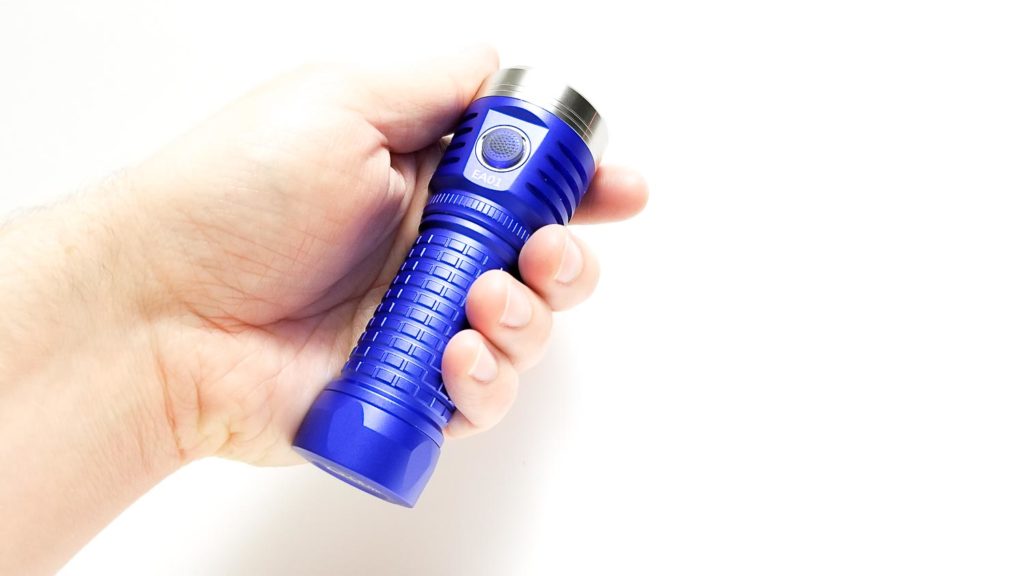
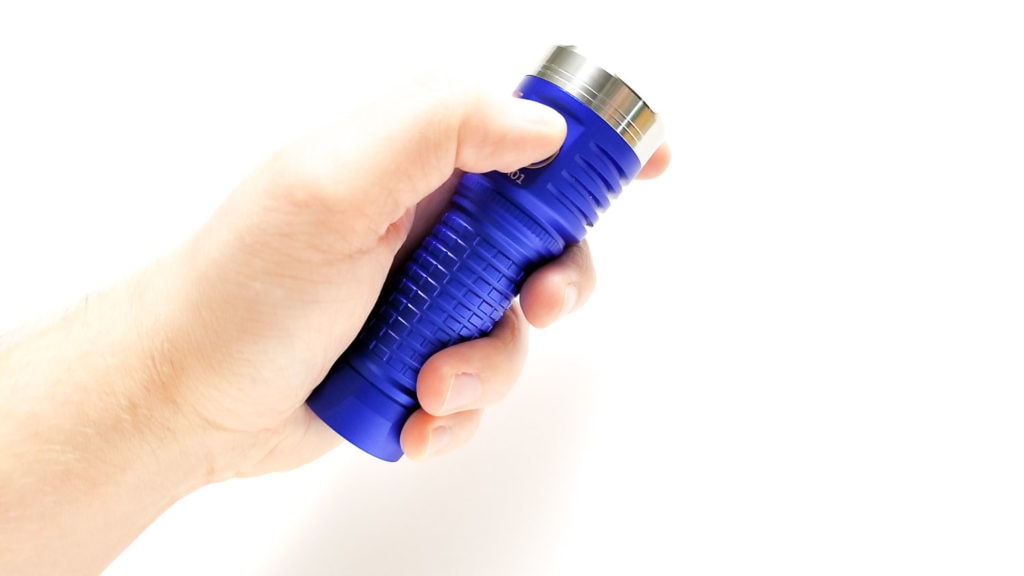
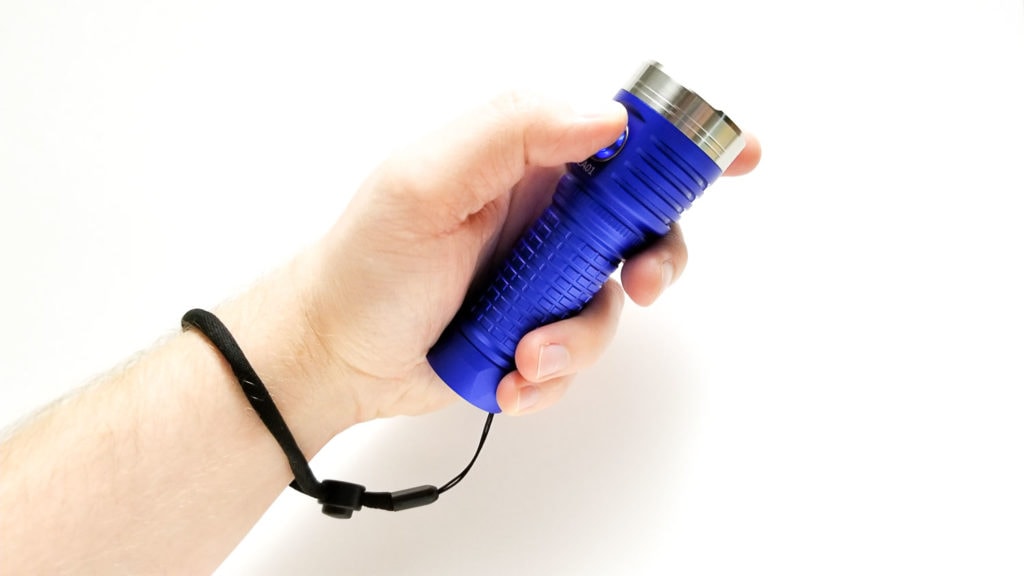
Build Quality, and Warranty
Okay, who made the EA01 for Astrolux? If you guessed Mateminco, give yourself 5 gold stars because the Mateminco MT01 is the EA01, or is the EA01 the MT01? Either way, the two lights look identical.
The build quality is fine and the machining is perfectly acceptable with no major defects and about what I’ve come to expect from Astrolux lights. I did notice some edges on the heatsink fins and bezel that were a little sharper than expected. The anodizing is type III, which is a nice semi-matte finish. It looks really good with no defects or coverage issues. You get 3 color choices with the EA01: Black, grey, and blue. I received the blue version, and honestly, I’m really digging the Smurf blue color!
I did notice that the brass positive contact on the driver was covered in a black residue that looked like it would affect the electrical contact, but it was easy to clean it off with isopropyl alcohol.
The battery tube has rear triangular cut threads that are fully anodized and seem a little on the fine side. The upper threads are the same, but shorter and are not anodized. Everything screws together smoothly and is sufficiently lubed, but if you are ham-handed like me, be careful when removing or replacing the tube since it seems easy to cross thread into the head. The tailcap is also under a lot of tension from the long tail spring, so be careful when screwing it on since it takes a bit of force.
It is nice to see that nothing is glued, and the bezel and the driver are easy to remove for modding or maintenance. Every joint is o-ring sealed, and Astrolux claims IPX7 rating. It’s believable since the charge port is well sealed with a silicone rubber plug and makes a hiss noise like opening a can of soda when prying open the cover after inserting a battery. Nice! You can even Lego the EA01 and Astrolux FT02S battery tubes and tailcaps. I found that the FT02S looks positively ridiculous with the stubby 26350 battery tube on it.
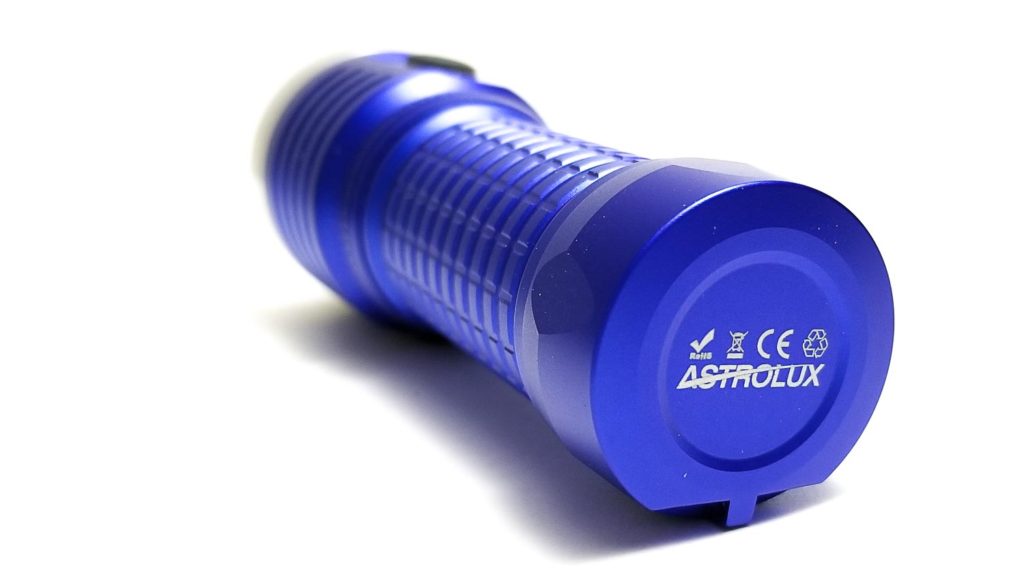
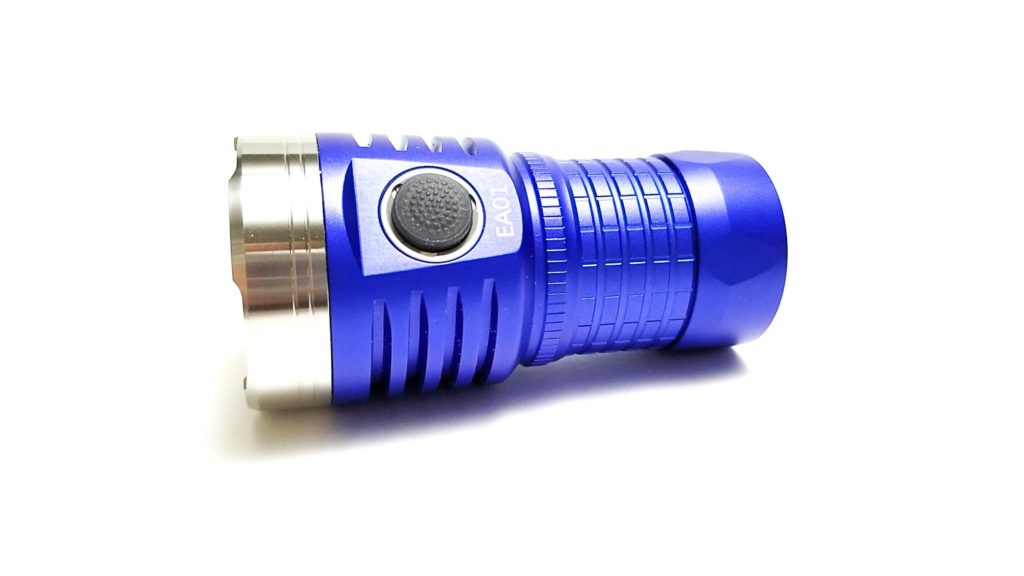
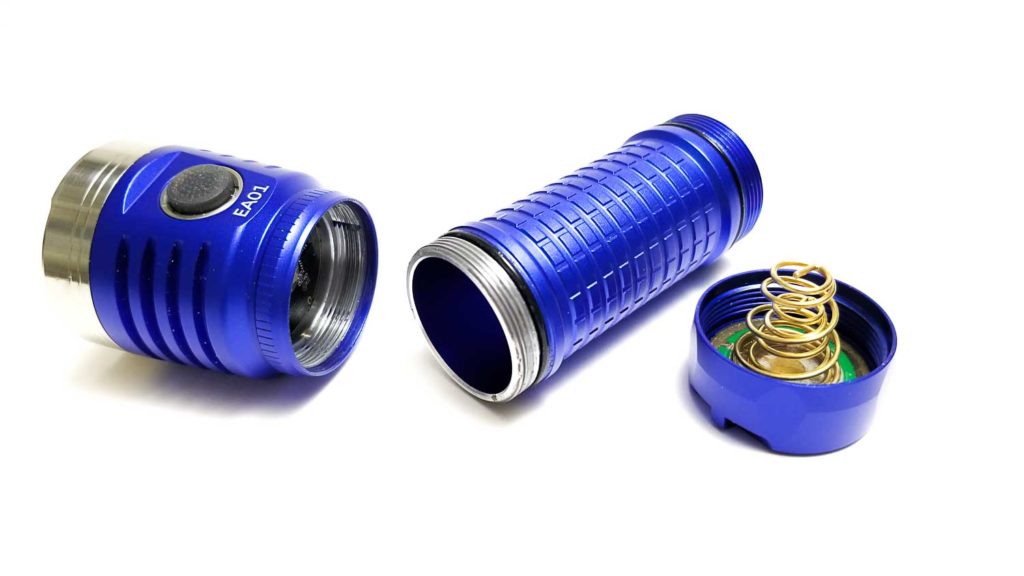
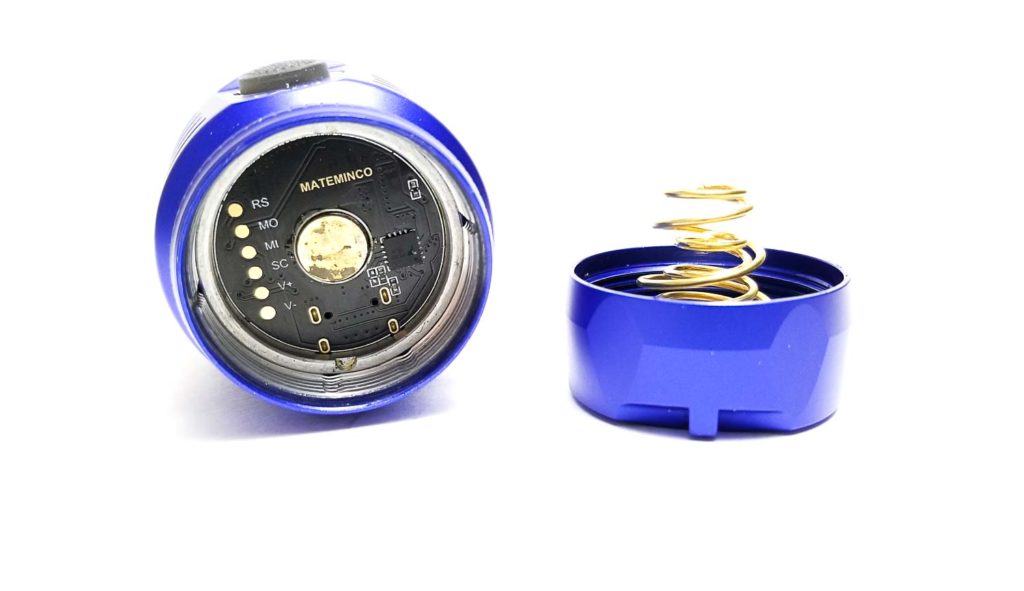
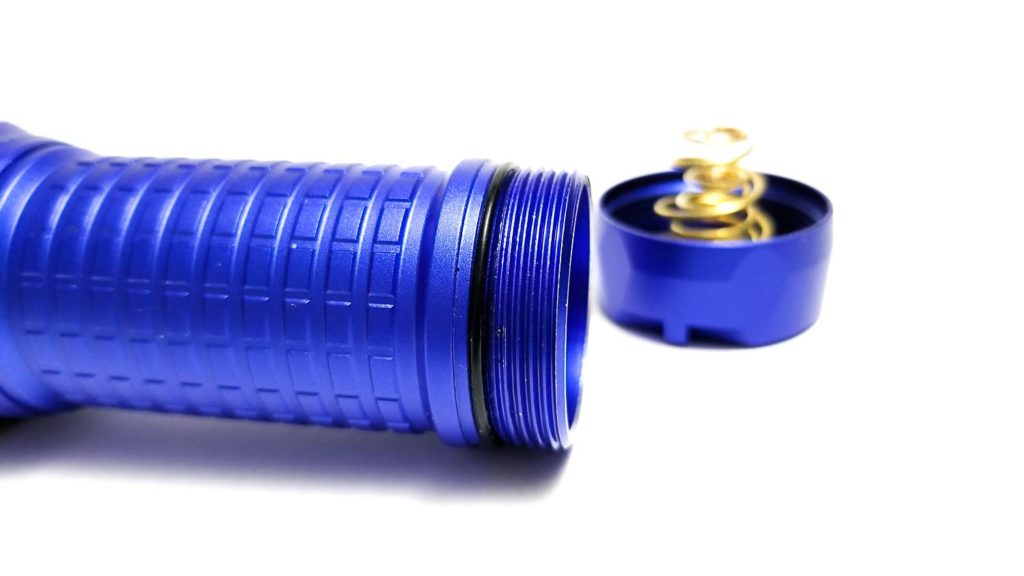
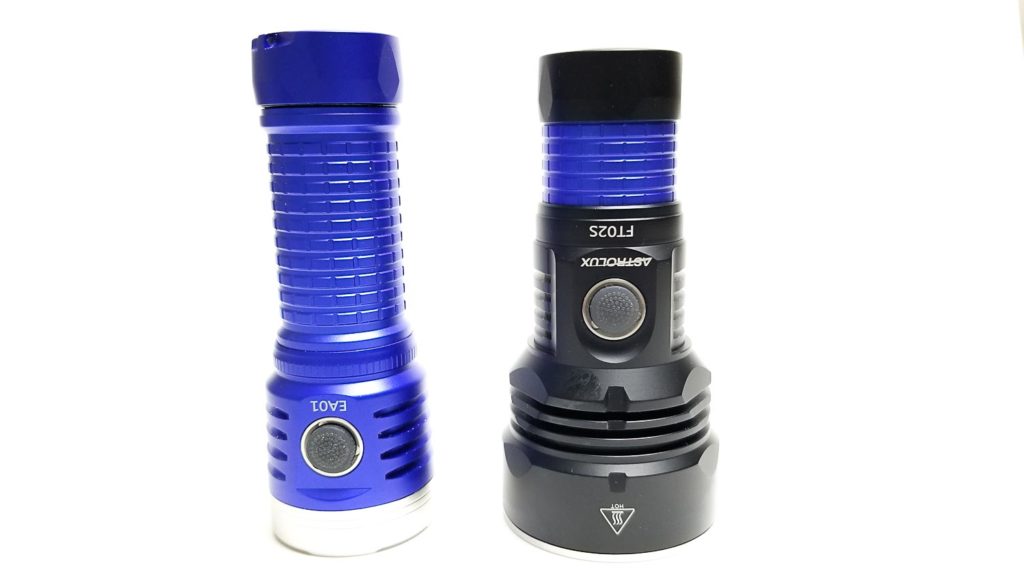
LED, Lens, Bezel, and Reflector
The Astrolux EA01 ditches a reflector in favor of a PMMA plastic optical lense. This type of optic works on the principle of total internal reflection (TIR). A good example is how the items in a water-filled aquarium reflect in a mirror-image off the surface of the water when looking from underneath. There’s a lot of complex math and science that goes into making an optic that makes my brain hurt, so check out this link for more information: https://www.ledil.com/support/guide-to-tir-lenses/
I opened the head to have a look, and the optic looks similar to the one that comes with the Acebeam E10 and Manker MC13. I measured the optic and it’s 35 mm wide by 20 mm tall with a hollow central area. The LED sits under a frosted section that I assume smooths and softens the beam.
You get two LED choices, either the Cree XHP50.2 (3 volts), or the venerable Luminus SST40 in two color temperatures: 5700K or 6500-7000K for the 50.2, or 5000/ and 6500K for the SST40. This light came with the XHP50.2 in 6500-7000K. I was glad to see the optic is protected by a toughened mineral glass lens with a nice, nearly invisible AR coating. The stainless bezel will do a good job protecting the lens from drops, and it does have some shallow crenulations so you can see if the light is on when placed bezel-down on a flat surface.
Optics are known to help mitigate undesirable beam characteristics, and in the case of the XHP50.2, which suffers from an often obtrusive corona and tint shift, the optic does a good job with minimizing those. The optic gives a good balance of throw and some spill, with a very smooth transition from spill to the defined hotspot. It’s very useful for both short and mid-range. The throw is impressive, and while there is less spill than the C8 with an SMO reflector, the hotspot is larger and the overall beam quality is better.
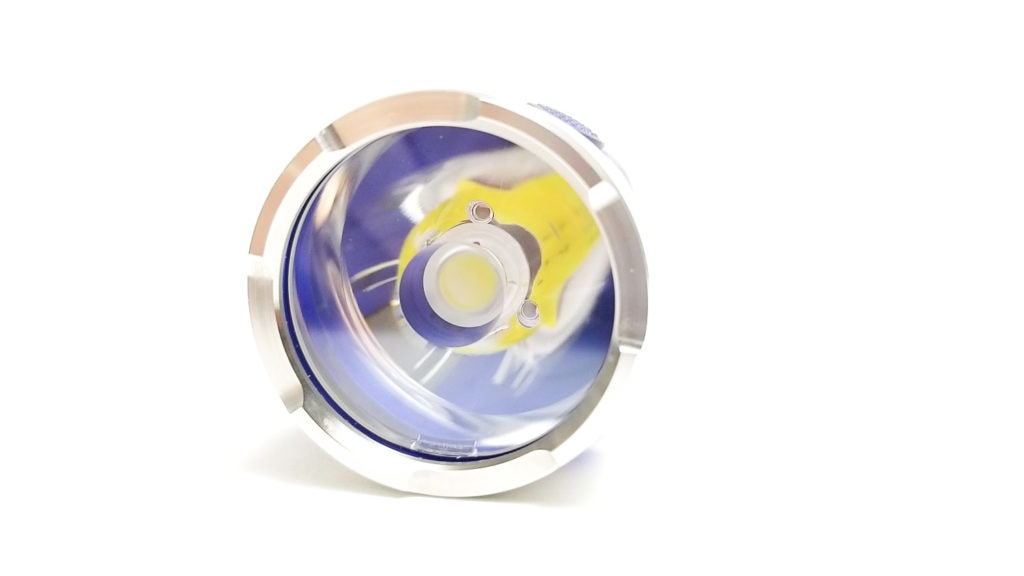
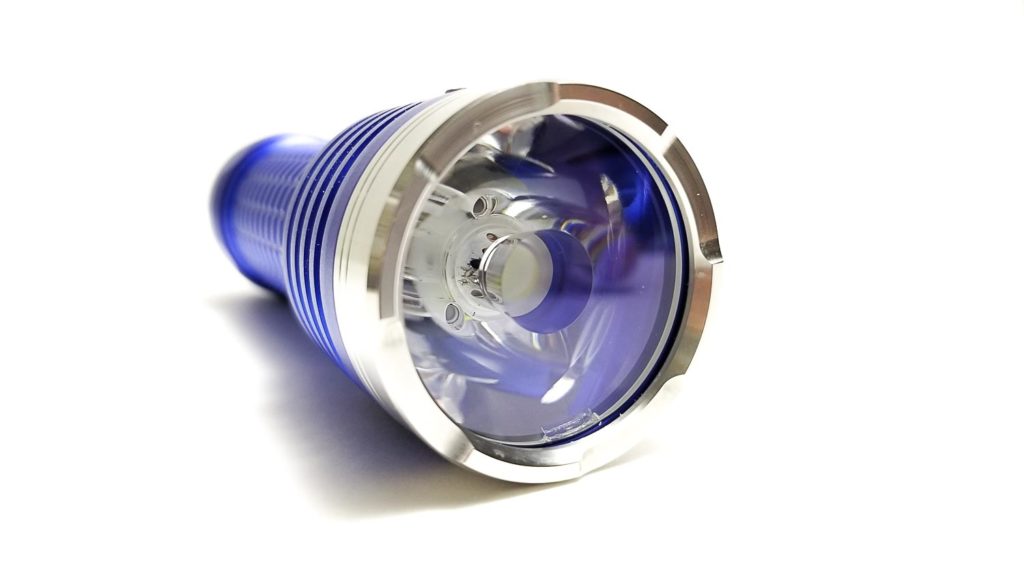
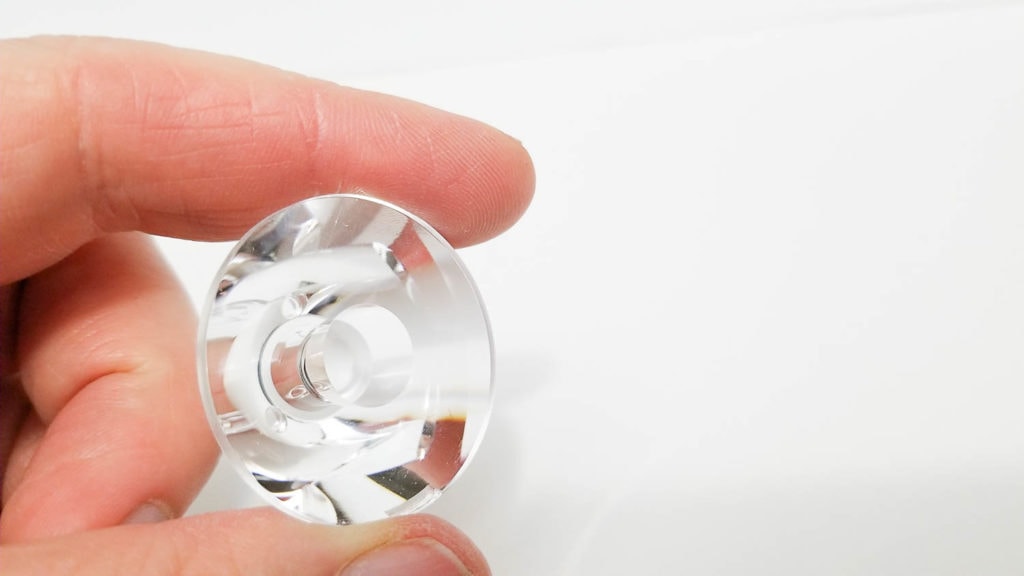
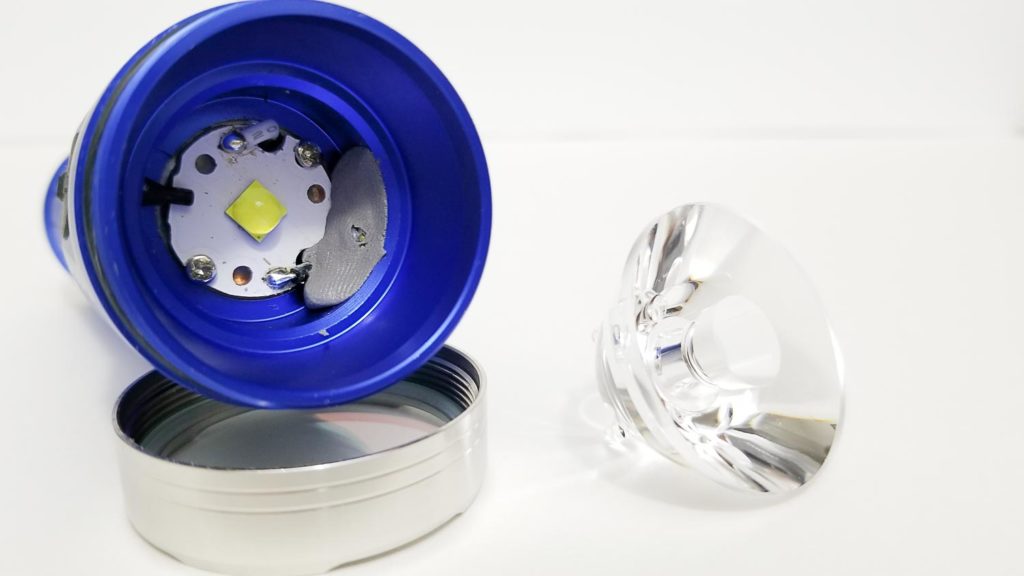
Dimensions and size comparison
- Length: with 26650 tube 116 mm / 4.56 inches. With 26350 tube 81.5 mm / 3.20 inches
- Head diameter: 41 mm / 1.61 inches
- Body diameter: 34 mm / 1.33 inch
Weight:
- Without battery, 26650 tube: 160 gr / 5.64 oz with Molicel P42A 233.10 gr / 7.86 oz.
- Without battery, 26350 tube: 120 gr. / 4.32 oz.
Flashlight Size comparison
Compared to other Astrolux Flashlights.
Left to right group 1: Astrolux EA01, Astrolux EC03, Astrolux FT02S.
Group 2: Acebeam L17, Astrolux EA01, Thorfire C8
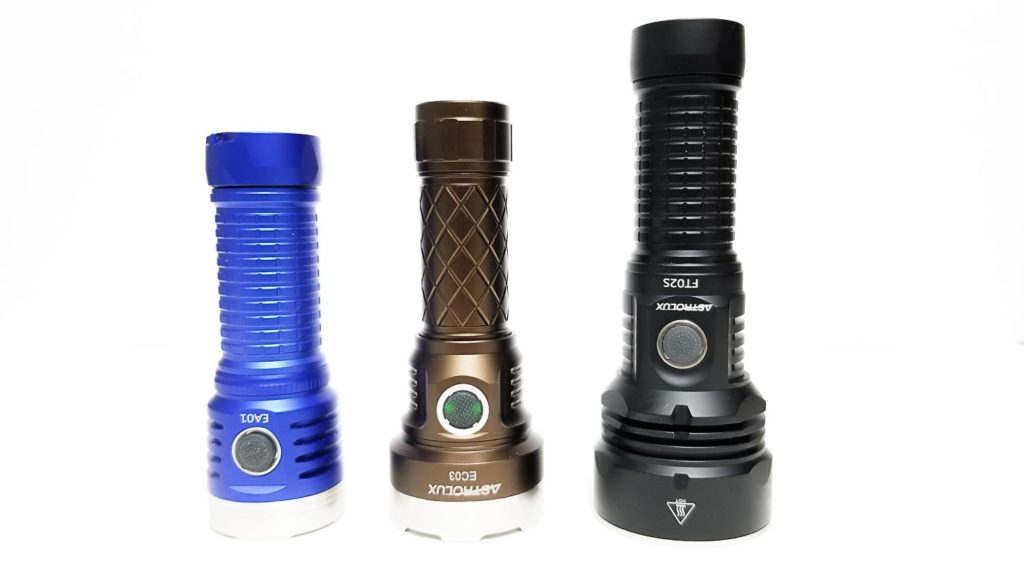
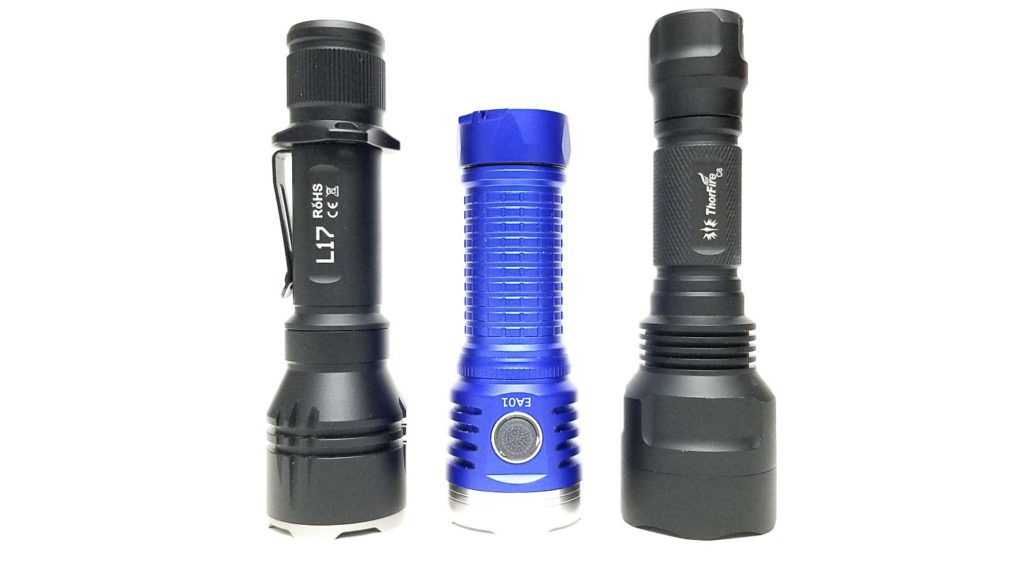
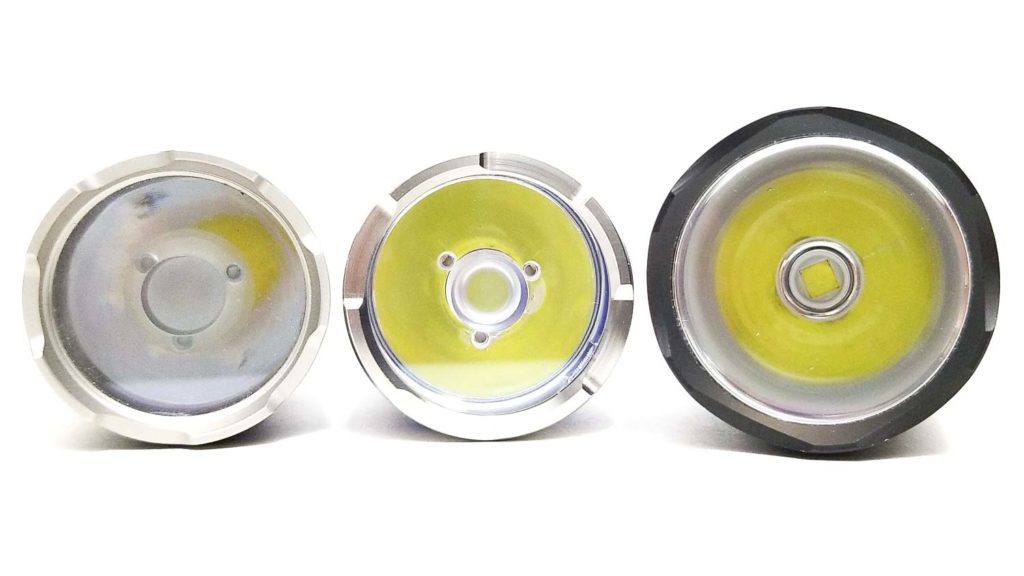
Driver & User Interface:
Commensurate with mainstream enthusiast lights these days, the Astrolux EA01 comes loaded with ToyKeeper’s Anduril UI. The driver looks identical to the Astrolux FT02S driver. It’s an FET+1 design, with regulated lower modes and an FET for turbo and higher modes controlled by PWM. The backside of the diver has a brass button as the battery positive contact (great for maximum current handling), the USB charging IC, and exposed flashing pads for updating the UI for those who wish to do so.
By default, the UI is set to smooth ramping with instant access to turbo, but you can also opt for stepped ramping with the number of steps and discrete brightness levels being configurable. The default stepped mode has 7 well-spaced brightness steps. Other options include a momentary mode for emulating forward clicky action, and a “muggle” mode, which runs the light at a lower output. You also get the mandatory electronic lockout, temperature check, and battery check.
Modes:
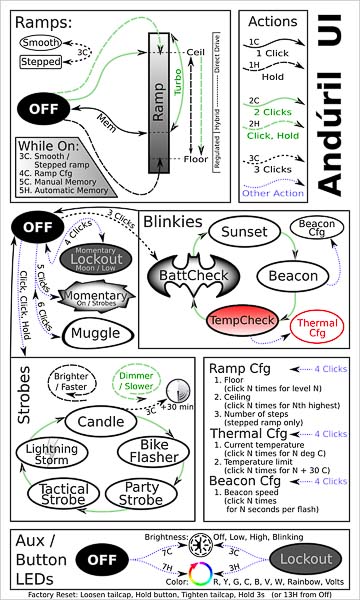
From OFF:
- Single-click: ON
- Double click: Top of the ramp. Double click again for turbo
- Triple click: Access the utility modes
To get into the special modes,
From ON:
- Press and Hold 1 sec. turns the light off
- Single click: Low/Eco. Click again to change to next mode
- Double click: Turbo
- Triple click: Strobe
- 4 clicks: N/A
Mode memory:
- Yes, last mode memory
Low voltage warning:
- Yes. By default, Anduril will start decreasing output as the battery drains until it reaches 2.8 volts and turns off the light. The switch aux LEDs will also change color to indicate battery state as well.
Strobe/blinkies
- Many available!
Lock-out mode:
- Yes
PWM
- There is PWM in all but the lowest modes, but it’s fast PWM and not visible with the naked eye.
Add additional info: Anduril is a very advanced UI, but I think a novice could easily learn how to use it quickly. I recommend checking the thermal configuration since this impacts how fast the light throttles back. My sample’s calibration for the ambient temperature was way off out of the box at 34.7 C compared to 23 C ambient, so make sure to check that before using the light for the first time or it may not perform to full potential.
Batteries & Charging
The Astrolux EA01 is designed around the 26650 size battery, but can accept 21700, 20700, and 18650 batteries thanks to the included adapters. In addition, the included short battery tube also allows use of the oddball 26350 (35 mm long by 26 mm diameter) cell. I didn’t have any to test, but the 26350 cells are more of a novelty than anything, since the highest capacity 26350’s are less capacity than a 30T and have much lower discharge current capability.
You will get the highest output on a 21700, and the longest runtime on 26650 I tried a 78 mm long protected Acebeam 21700 and I couldn’t screw the tailcap on, so be aware that cells over 70 mm will be a tight fit, or may not fit at all.
The light includes built-in USB type C charging, so you don’t need a separate charger. However, you DO need a USB type A to C cable since one isn’t included. The switch button is a dual-tone red/blue when charging, and goes solid green when charged. The battery was charged to 4.18 volts. Something to keep in mind is the onboard charger won’t charge the battery at full power if it’s over 4.18 volts so if you want the max capacity out of the cell, use an external charger.
Astrolux specifies a 2 amp charge current for the built-in charging, and I tested that with my Hidance USB tester using a 2.1 amp wall charger. I saw 1.80 amps on a discharged Molicel P42A. This seems low, but there is some current loss in the buck circuit that steps down the 5 volts input from the USB charger to the 4.2 volts the battery needs. The output current is actually closer to 2 amps.


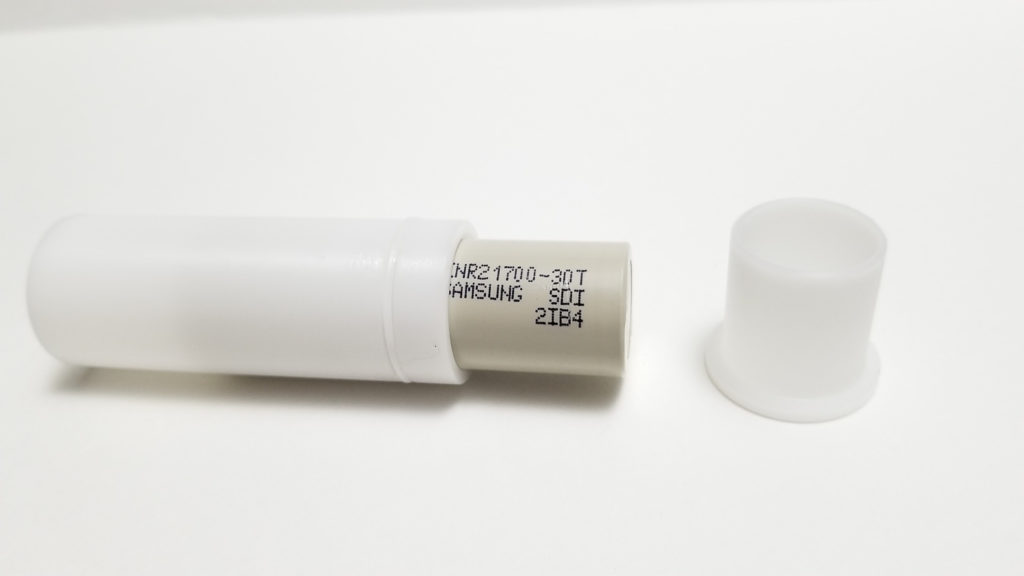
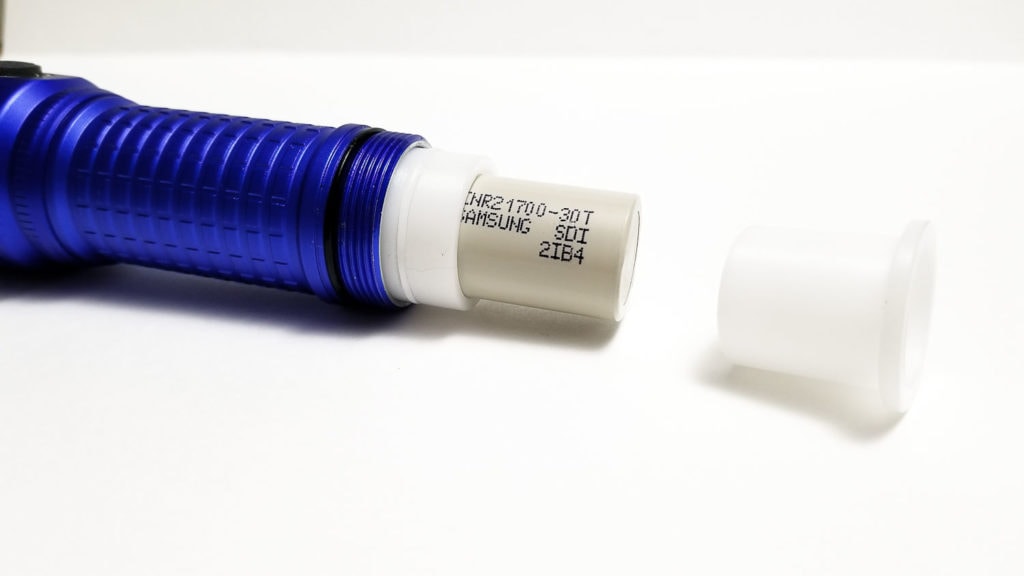
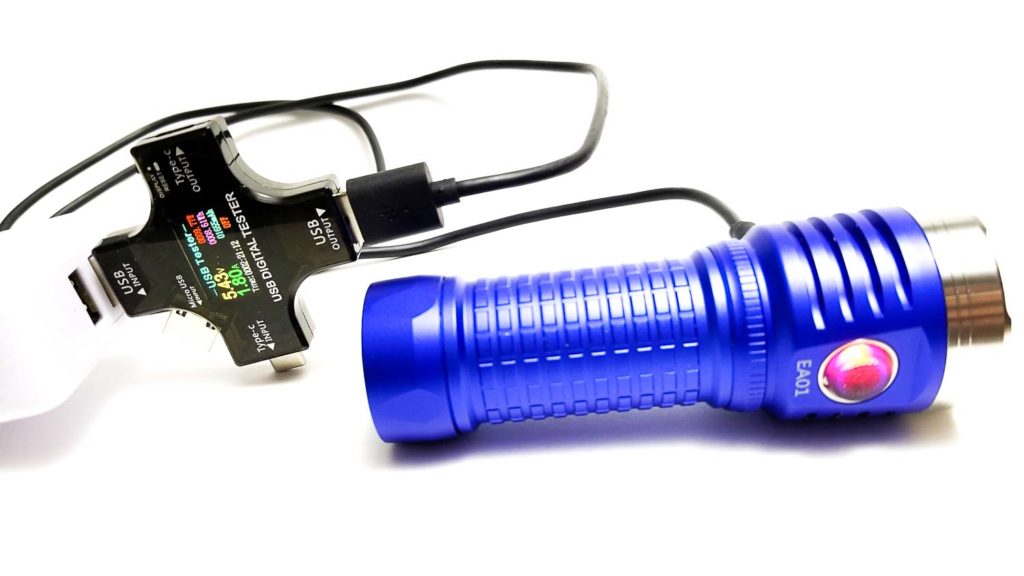
Performance
My favorite part! A single XHP50.2 3 volt and an FET driver means high output. The Astrolux FT02S drove the quad XHP50.2’s pretty hard and I got over the advertised output figures so we will see how it goes.
Amp measurement
For the current measurement, I used my Radio Shack T-RMS multimeter with short 16 gauge wires inserted directly into the meter for modes under 7 amps, and my clamp meter with a short piece of 12 gauge wire for the higher modes. The parasitic drain was 0.21 mA. Something to keep in mind is Anduril gives you the option to turn off the switch indicator lights.
I used a fully charged Samsung 30T 21700 for the current test using the stepped modes and turbo.
- 1: 14 mA
- 2: 70 mA
- 3: 212 mA
- 4: 560 mA
- 5: 1.35 A
- 6: 2.58 A
- 7: 5.56 A
- Turbo: 11.87 A (at turn on)
Hmmm…Only 11.87 amps on turbo seemed low for this setup, since the 50.2 at 3 volts pulls a lot of current from a 30T. I did some troubleshooting and thoroughly cleaned the contacts and re-seated the driver retaining ring and got a slight increase, but nothing remarkable. Maybe my sample is under-performing a bit?
Runtime graph
For the runtime tests, I used the 30 cm integrating sphere calibrated with a light of known output and the Digi-Sense 20250-00 data logging luxmeter. Temperatures were measured with my Ames non-contact thermometer. I used a Molicel P42A 4200 mAh 21700 and tested stepped modes 4, 5, 6, 7, and turbo. I set the thermal configuration to max (70 C) for the step down, and calibrated for 23 C room temperature. I didn’t test the lower 3 levels since they would run for days.
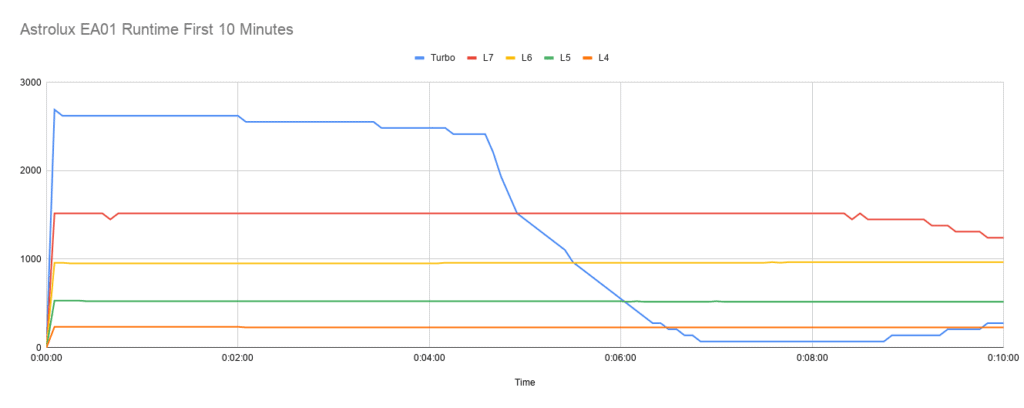
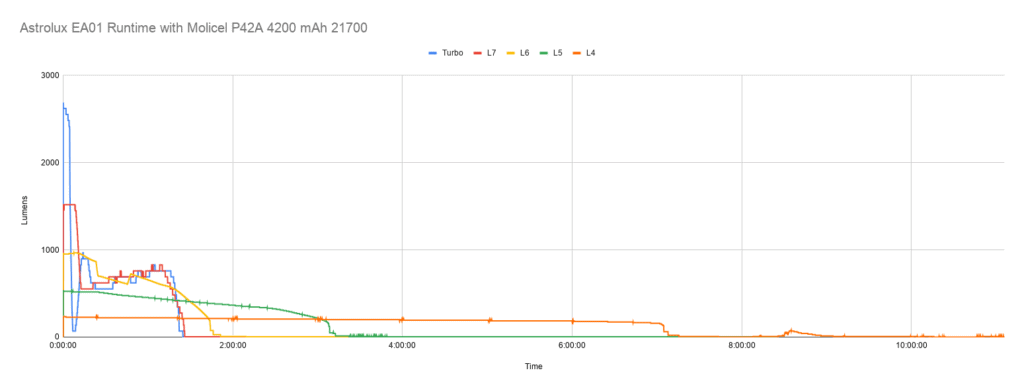
Turbo started almost 2700 lumens and held that for over 2 minutes before stepping down gradually over the next 5 minutes. I was pretty impressed with how it held over 2500 lumens for 3 and a half minutes. At the 4 minute 50 second mark, the output really dropped, and at 6 minutes 50 seconds, it was down to a very low output where it stayed until the temperature came down and the light throttled back up again. This cycle repeated until 1 hour and 24 minutes into the test when the output dropped to under 4 lumens where it remained for a while until I ended the test. From experience, Anduril will drop to the lowest output until the battery dumps, which might take days.
Once properly calibrated and the ceiling set, Anduril does a good job at maintaining the temperature ceiling and holding the output steady. The downside is the light gets hot, and stays hot. On turbo, I saw a high of 70.1 C at around 10 minutes, and level 5, 6, and 7 all were around 60-65 C for the duration of the test. The battery tube stayed toasty at between 62 and 60 C.
Level 7 was a mirror image of turbo, albeit with lower output at around 1581 lumens. Total runtime was nearly identical to turbo, with the output dropping very low to under 4 lumens at around the 1 hour and 26 minute mark. Like with turbo, I ended the test after a while of running on the low setting.
Level 6 started at 959 lumens, with some throttling over the next 18 minutes, but it never went below 900 lumens, which was impressive. It behaved like level 7, with gradual decreases in brightness until 1 hour 26 minutes when it dropped to 4 lumens where it stayed for the next 27 minutes until I ended the test at 3 hours 53 minutes. Level 5 started at 530 lumens where it stayed pretty consistently for the next 31 minutes, eventually dropping to 496 lumens. The output was consistent at over 400 lumens for the next hour before gradually dropping off to under 100 lumens at around 3 hours 10 minutes, then to a very low level at the 3 hour, 22 minute mark. I ended the test at the 8 hour, 24 minute mark. Level 4 was rock-solid output at 200 lumens or more for almost 4 hours, tapering down to a very low level like the other modes until I ended the test at the 11 hour, 7 minute mark.
What did we learn from these tests? The FET+1 driver combined with Anduril is capable of high output and really long runtimes because the driver eventually switches to the AMC7135 regulator for low output. Every time I test an Anduril light I come away with a deep appreciation for the temperature regulation. I didn’t see any sawtooth or rollercoaster behavior, and I like the fact I can set the thermal ceiling to keep the light cool enough to touch. The EA01 has decent heat sinking, and running on turbo it took the better part of a minute before I could feel any serious heating in the head. Runtimes were good, and about what I expect from the P42A. Yes, it gets hot and stays hot in the higher modes (I didn’t observe high temps in mode 4), but you can always set the thermal limit lower if needed. The battery was consistently discharged to 2.8 volts during each test.
Lumen measurements (for each mode)
Output figures are relative to my 30 cm homemade integrating sphere. Lumen measurements are taken with a Digi-Sense 20250-00 data logging luxmeter calibrated with a light of known output. I calibrated the ambient temperature and thermal ceiling to 70 C. I used a fully charged Samsung 30T 21700 for the test. All readings taken at 30 seconds on each stepped mode. Level 7 didn’t drop much in 30 seconds, and I was surprised how little turbo dropped also.
| Step | Lumens | Advertised |
| 1 | 4.8 lumens | ? |
| 2 | 28.9 lumens | ? |
| 3 | 89.7 lumens | ? |
| 4 | 243.5 lumens | ? |
| 5 | 552 lumens | ? |
| 6 | 1021.2 lumens | ? |
| 7 | 1656 lumens (1690.5 at turn on) | ? |
| Turbo | 2760 lumens (3105 at turn on) | 3500 lumens |
(Pause for contemplative chin-scratching). Hmmm. My numbers are on the low side again, but makes sense given the figures I got in the current test. I switched to the Uni-T UT383S lux meter and got better numbers on turbo (3757 lumens at turn-on). However, the Uni-T always reads high (10% up to 18% on the high end), so I do not trust the numbers to be an accurate representation of the actual output. Perhaps my sample is slightly underperforming?
Throw numbers:
Throw was measured indoors at 5 meters with the fully charged Samsung 30T and the Uni-t UT383S luxmeter. I tested the stepped modes in addition to turbo. The Banggood specifications for the light only advertised a single throw measurement, so I assumed it’s turbo.
| Step | Throw | Advertised |
| 1 | N/A too low | ? |
| 2 | 375 cd, 38.72 m | ? |
| 3 | 1425 cd, 75.49 m | ? |
| 4 | 3975 cd, 126.09 m | ? |
| 5 | 9800 cd, 197.98 m | ? |
| 6 | 16,925 cd, 260.19 m | ? |
| 7 | 28,200 cd, 335.85 m | ? |
| Turbo | 49,625 cd, 445.53 m (52,625 cd, 458.80 m at turn-on) | 68,000 cd, 521 m |
Beamshots
The throw is down from Astrolux’s figures, but again, not surprising given the output. Still, 458 meters is pretty fantastic for a light this small with a 50.2.
Outdoor shots: I compared the Astrolux EA01 with the 30T to a modded Thorfire C8 which has a 6000K XHP50.2 behind an high output FET+1 driver on a Sony VTC6 18650. The distance to the wall is 100 meters in the first photos. The brick wall is 20 meters away, and the fence in the last photos is about 35 meters distant. You can see how the Astrolux EA01 matches the Thorfire C8 on throw, even though the C8 beats it on lumen output. The TIR helps minimize tint shift and corona, which are more pronounced in the reflector light. The hotspot on the reflector light is a bit tighter and has more spill, but the spill to hotspot transition is less pronounced and diffused on the EA01. Some enthusiasts prefer this, some might not, but I think this is a great example of the strengths and limitations of a reflector and TIR optic.


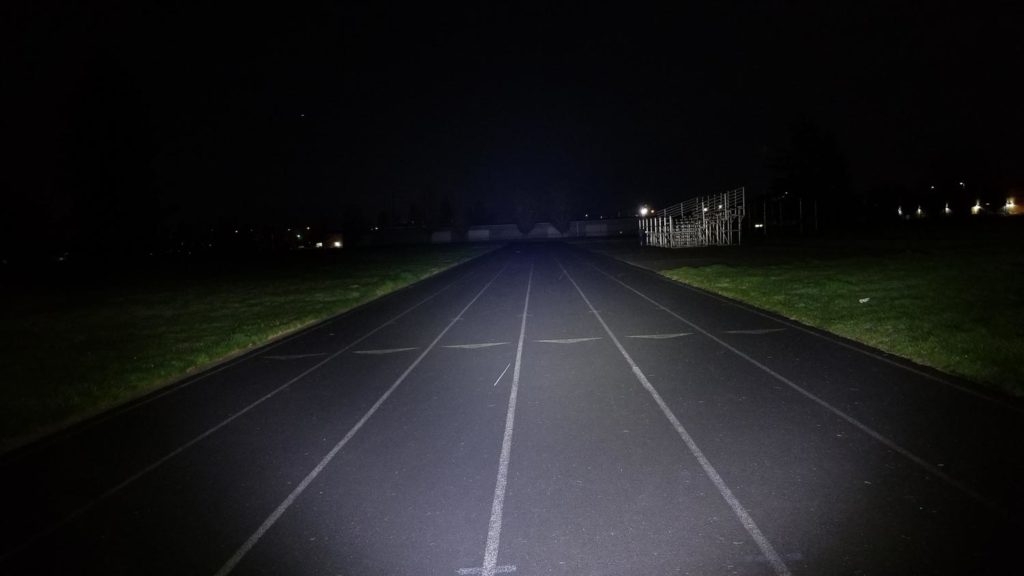
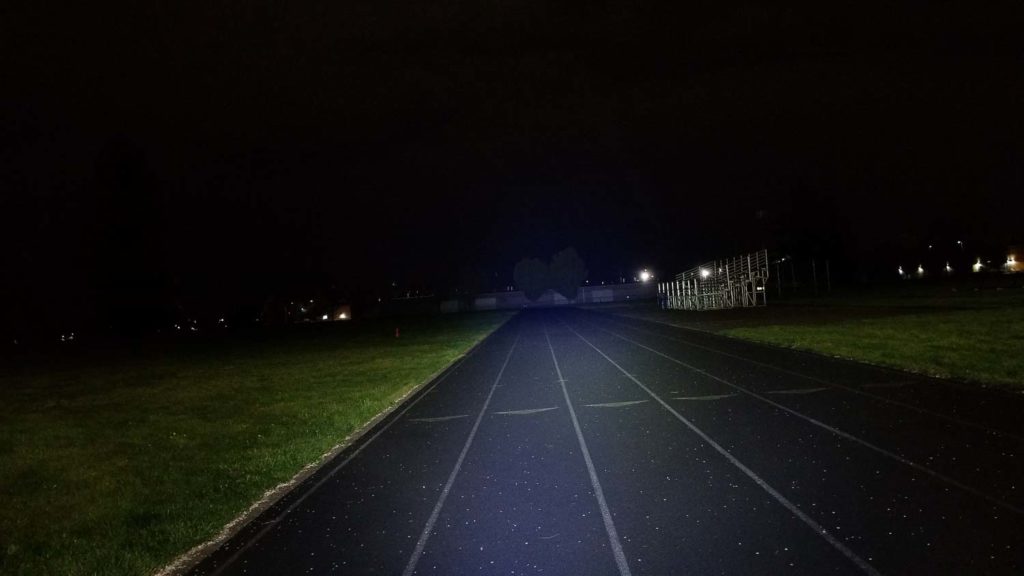
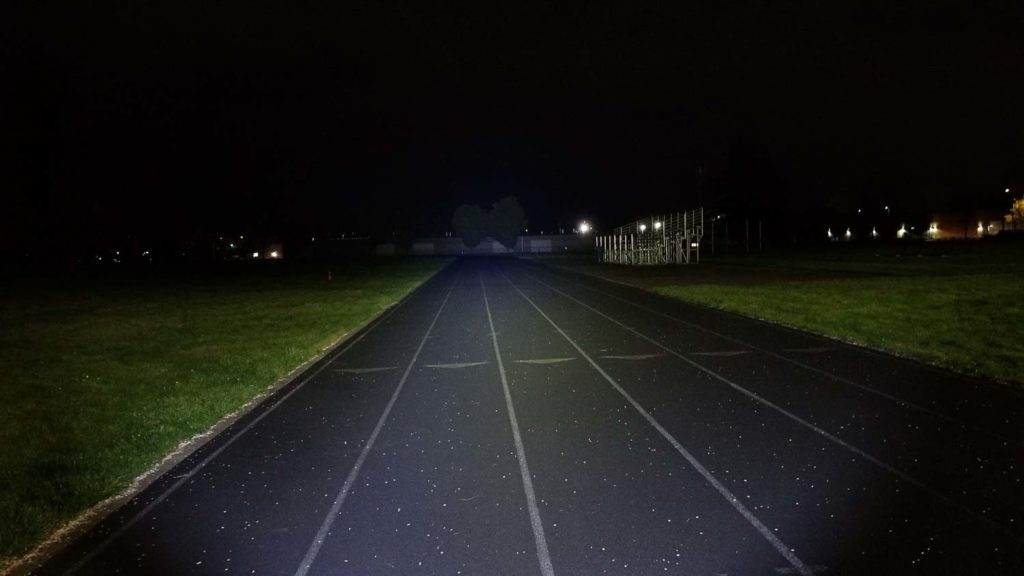
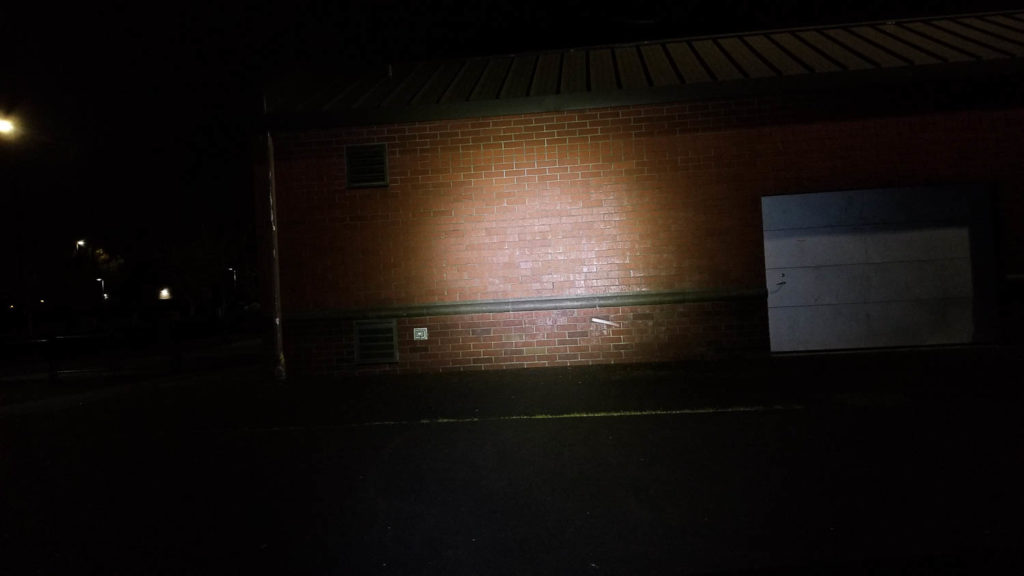

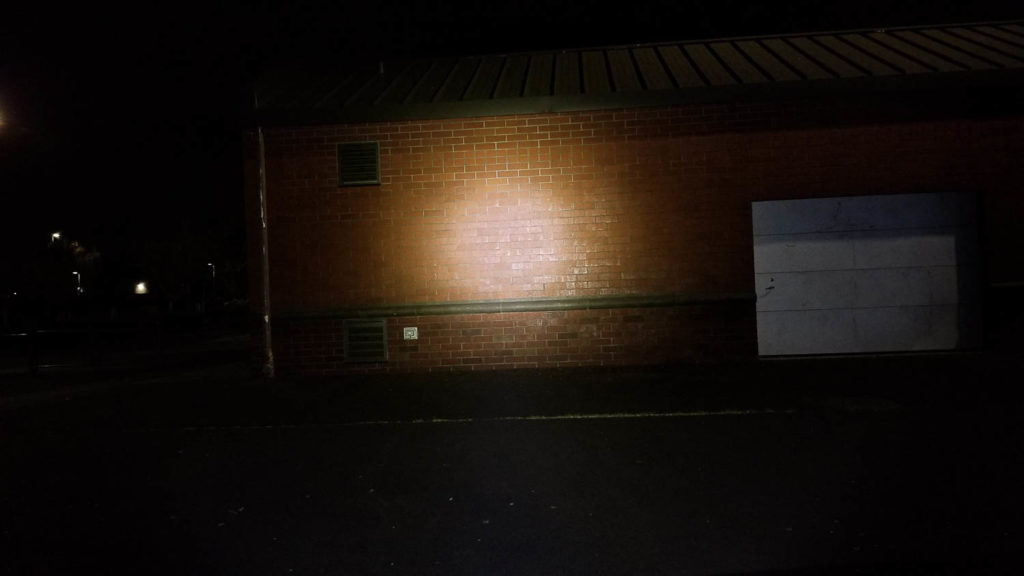
Disclaimer: This flashlight was sent to me for review at no cost by Banggood. I have not been paid to review, nor have I been holding back on problems or defects.
Explanation on star ratings:
- – Avoid: my phone flashlight would be a better choice
- – Poor: significant defect or issues, much better options available at the same price
- – Average: some defects or issues
- – Good: recommended (minor issues)
- – Great: highly recommended
Final Verdict
Pros
- Decent quality with nice finish
- Compact
- Pretty bright
- Throws good
- Built in 2 amp charging
- Takes 26650, 20700, 21700, 26350, and 18650 batteries
- Anduril UI
Cons
- Didn’t meet advertised output specs
- Thermal configuration was way off out of the box
- Sharp edges on bezel and cooling fins
- Undersized lanyard hole

4.5 stars: ★★★★⋆
Okay, time to be honest. I was a bit skeptical of optics as viable replacements for the tried-and-true reflector, but now I am fully convinced that optics are a legitimate alternative. Acebeam proved to us that you can get a ton of throw out of a sub-70 mm optic with the L19, and we all know what manner of flood we can get from the Noctigon D18. Where does the Astrolux EA01 fit in? I think the addition of a TIR optic has given the EA01 great throw without giving up too much side illumination all while minimizing the undesirable characteristics of the XHP50.2.
In addition, this is a well-made, utilitarian and good-looking light. I like how it takes just about all round 18 to 26 mm cells from 35 mm to 70 mm long, the driver is well-regulated and works great with Anduril. On-board quick charging that actually works is always nice also. I was a little disappointed in the output since I was expecting more out of it, and things like the too-small lanyard hole (Banggood, what’s a guy gotta do to get a properly-sized lanyard hole?) and the thermal calibration being way off were annoying. I digress though, because as-is, the Astrolux EA01 is versatile with good performance, and will be put to good use for sure. 4.5 stars for the EA01.
Astrolux EA01 for sale
The Astrolux EA01 is no longer available at Banggood. Instead, check out our list with some of the best EDC flashlights we reviewed.
1lumen selects and reviews products personally. We may earn affiliate commissions through our links, which help support our testing.